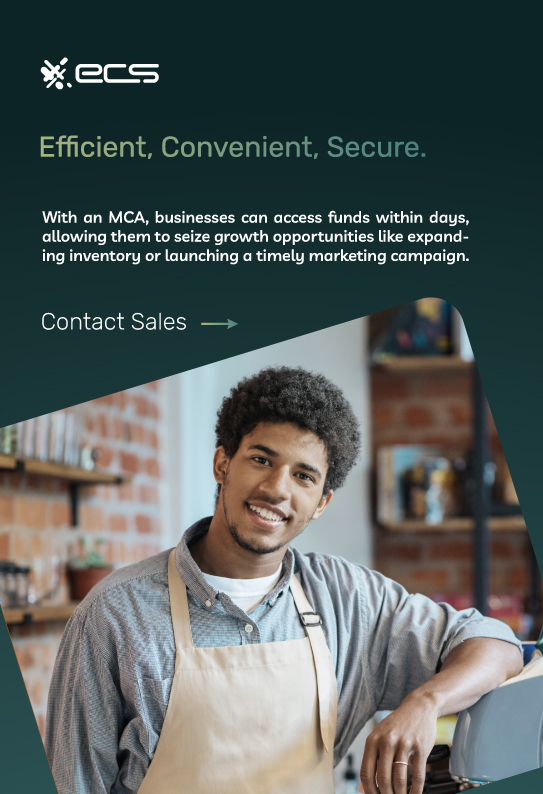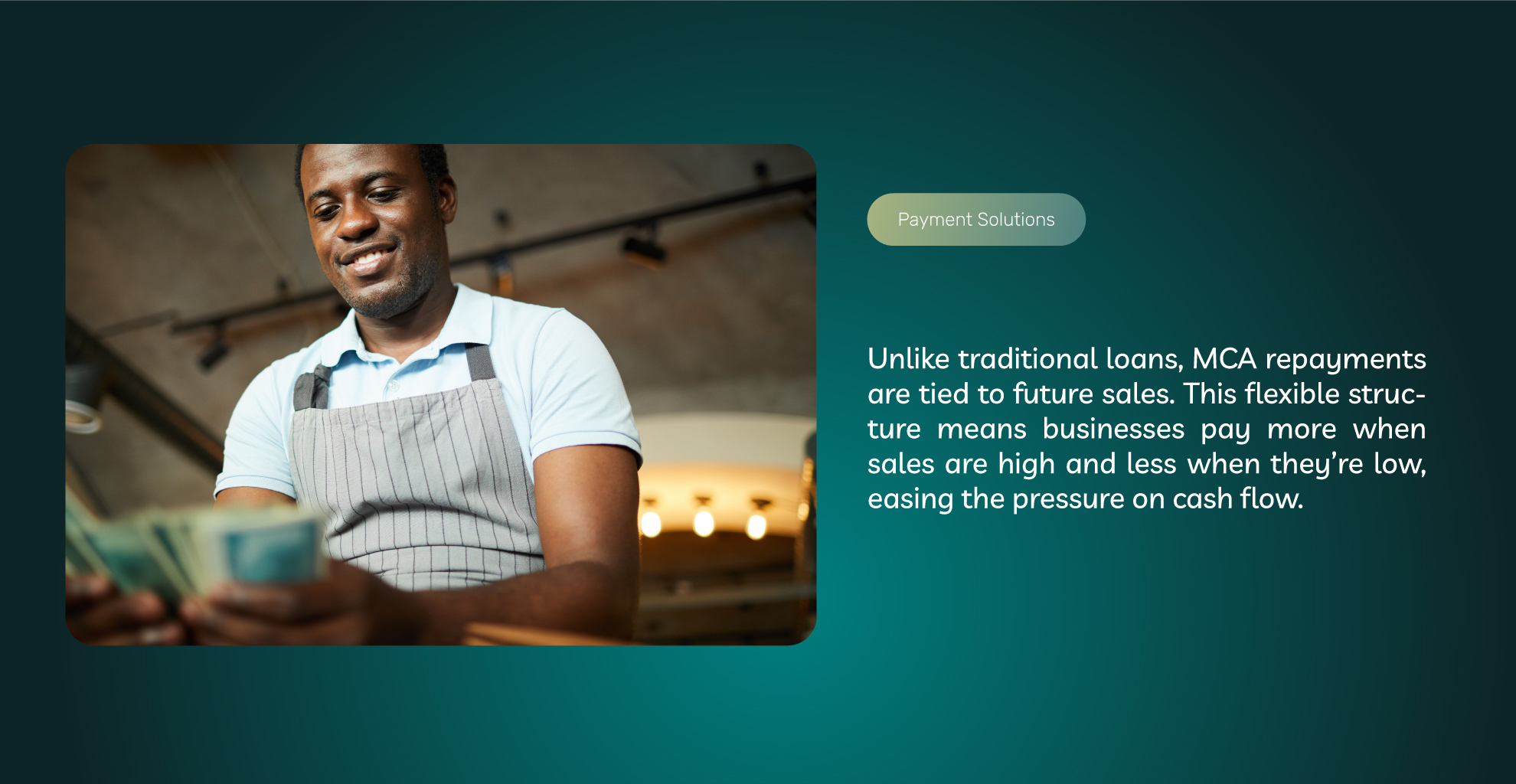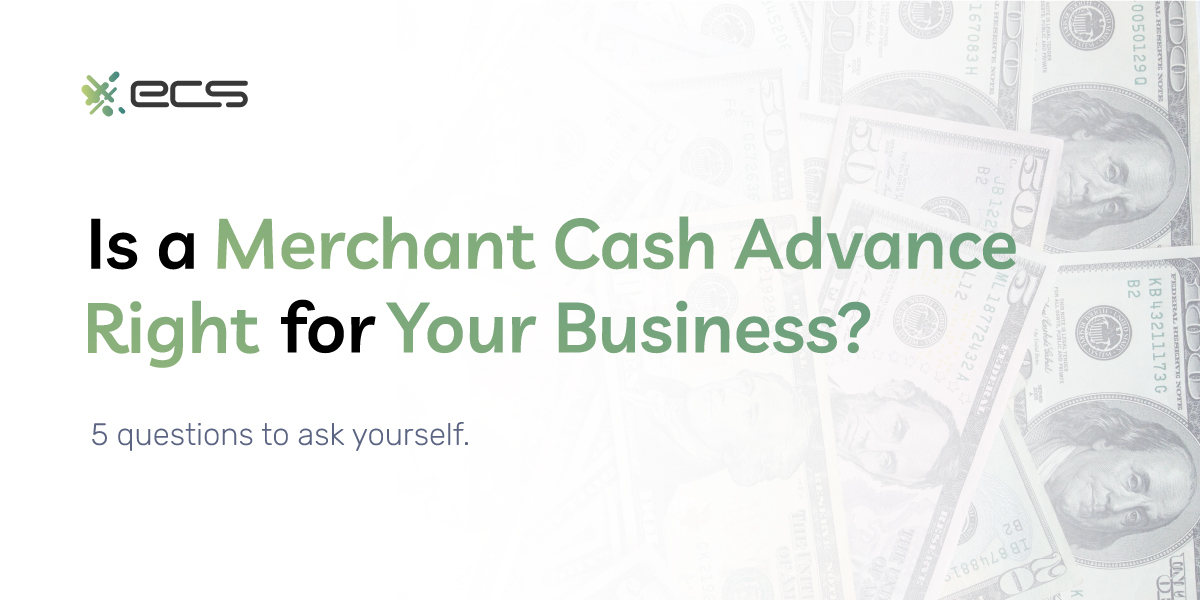You’re a small business owner in need of money now. Traditional bank loans will take too long. You don’t want to add to your credit card balances and lower your business credit score. Are there any other forms of financing? What if you could get quick funding in exchange for a set percent of your daily credit card sales? Let’s explore how a merchant cash advance (MCA) works.
Understanding Merchant Cash Advances
A merchant cash advance is different from other types of financing options. It is only available for merchants who accept debit and credit card payments. Why? Because repayment for the MCA is drawn from those debit and credit card transactions.
As such, the lender of an MCA may care more about your sales volume than your credit score. For businesses with robust sales volume, an MCA may be more appealing than some traditional financing options like loans or credit cards—and easier to get, especially if the business doesn’t have an established or good credit history.
Merchant cash advances are typically not the best option for long-term financing. However, they can be very useful for short-term gaps in cash flow—for instance, due to a slow season—covering imminent and unavoidable expenses like payroll, rent, and/or utilities. They can also finance urgent or emergency business needs—like an opportunity to buy fast-moving inventory that will disappear or get bought by a competitor.
A merchant cash advance decision should be made after evaluating an MCA vs. traditional financing. To break that down, here are a few questions you should ask yourself if you are trying to determine whether or not an MCA is right for your business.

Question 1: What Is the Current State of Your Cash Flow?
Repayment for a merchant cash advance is drawn from your incoming payments. You’ll need to assess your annual cash flow cycle to see if you can meet the repayment terms and still have money left over for your expenses.
Traditional lenders spend weeks assessing your creditworthiness and financial solvency. They have also been legislated into very tight requirements about what type of DTI (debt to income ratio) they can accept in a borrower.
An MCA is not tied to a credit score and is not as tightly bound by borrower-protecting regulations. As such, your lender won’t invest as much time assessing your ability to repay the MCA while also meeting your outstanding financial obligations. That will be on you to assess, which means you need to have a command of cash flow.
MCA repayments are typically fixed percentages of your sales. Your repayment schedule can be monthly, weekly, or daily. Understanding the nuances of your cash flow will help you make these payments on time.
For instance, if you have a consistent cash flow every day, you will be able to handle a daily repayment. But if your business enjoys most of its cash flow on the weekends or during a certain time of the month, weekly or monthly repayments make more sense. In summary, finding the best repayment terms for your business requires that you understand the ins and outs of your sales volume.
Question 2: What Will You Use the Merchant Cash Advance For?
There is no beating around the bush: merchant cash advances have very high buy rates. An MCA is not a great type of loan for expenses that will take longer to generate more revenue.
Renovations and business equipment are two types of purchases that typically should not be financed with an MCA. To be fair, renovating the customer-facing aspect of your business can ultimately generate more revenue in the long run—particularly if those areas are old, in need of repair, or have shag carpets and popcorn ceilings (no offense to the 70s).
Business equipment is another type of purchase that takes a long time to pay itself off and create unencumbered revenue. Both of these types of investments, renovations, and equipment are often better financed with something like a business loan or a second mortgage–HELOC (if your business owns property).
An MCA should be used to fund expenses that can quickly generate revenue, such as inventory or overhead—like payroll (if you can’t slash employee hours). Investments that quickly generate profit from additional sales will help make sure you keep up with the repayment of the MCA. Hot inventory—or even paying for staff to keep your business up and running—are two examples of revenue-generating investments for which an MCA would be fitting.
Question 3: Have You Considered All Financing Options?
Compare all your options during business financing decision-making. Is an MCA the right choice? An MCA is not a business line of credit. It’s a one-and-done arrangement that you will pay in installments throughout a fixed repayment period. How does an MCA hold up against other forms of business financing?
Credit Cards
Credit cards are another financing option that a business might consider. Some credit card companies offer a 0% introductory rate for 12, 18, or even 24 months. One problem with this particular financing option is that introductory offers are typically for consumer credit cards, which may have smaller limits than a business needs.
Some credit card companies offer a 0% rate promotion for direct deposit or balance transfers. The balance transfer can pay off a different card, freeing up credit for use. The direct deposit promo puts that money in your checking account at a low or even 0% rate. The problem with these options is that once the promo period is over, the rate will shoot up, and some companies even charge back-dated interest.
Small Business Loan
A business loan or SBA loan is another option that can be good for business owners. These loans will have larger limits and—particularly in the case of SBA loans—accommodating rates. The downside: such loans require extensive and lengthy underwriting processes. They can take days or weeks to originate. If time is of the essence, such loans will not work.
Private Investors
Some business owners look to private equity funding or angel investing. This option is often quick, with ample loan sizes. The downside is that the angel investor may demand involvement in company decisions—to become a board member if you will—a trade-off you might be unwilling to make.
A particularly creative solution for a credit dilemma is invoice fracturing. Invoice fracturing is selling your outstanding invoices to a third party. They will provide you with payment for the invoices and then collect those amounts from the parties that you have billed. A significant obvious risk to this method is creating a bad impression with your customers and clients, who find their expectation of continuity fractured by this maneuver (pun intended).


Question 4: Can You Afford the Total Cost of the Merchant Cash Advance?
Like any loan, it’s imperative that you understand the actual cost of the MCA. An MCA is different from a traditional loan or credit card. Rather than an APR (annual percentage rate), an MCA uses something called the factor rate.
The factor rate is a multiplier that will determine the total cost of the cash advance. For instance, a factor rate of 1.6 applied to a $50,000 merchant cash advance would result in a total loan obligation of $80,000. This does not include any additional fees such as alone origination fee, if applicable.
Factor Rate Vs. APR
Wondering why an MCA uses a factor rate instead of an APR? An APR essentially allows the borrower to take as long as they would like to repay the loan. An interest rate is applied to the balance every time they pay until it’s paid off. If the loan is paid off more quickly, the total interest paid will be much lower than it would be if the borrower takes longer to pay.
Not so with an MCA. The factor rate means the total amount of “interest” paid is set in stone. On the one hand, it forces you into a schedule of repayments that prevent the loan from being dragged out. But on the other hand, it means that you won’t be able to escape the “interest” even if you pay it off early.
Let’s return to our earlier example of an MCA for $50,000 with a factor of 1.6. Let’s also suppose that the borrower will have 18 months to repay this loan, and for the sake of keeping this example simple, there are no origination fees. This means that a monthly repayment would be $4,444. If you’re the SMB owner in this example, will your cash flow be substantial enough to cover that and your ongoing expenses?
Question 5: How Will the Merchant Cash Advance Affect Your Future Financing Options?
An MCA is typically not shared with credit reporting agencies. As such, a positive repayment history won’t improve your credit score. However, if the repayment schedule is too burdensome and/or your cash flow dips below expectations, it could become harder to service the rest of your outstanding debts.
Moreover, future lenders will probably know that you have an MCA. They’ll factor this debt into your DTI, making it harder to get a loan. If they are willing to extend a loan, the terms will be less favorable for you. The lender will need to mitigate their risk with higher interest rates and/or lower credit limits.
An MCA can also impact supply relationships. If cash becomes too tight because of the MCA, you won’t be able to pay invoices as quickly. You might need to request net-60 or even 90-terms if sales dip.
You can mediate some of these potential effects by reviewing all the terms of the MCA and negotiating them as favorably as you can. See if the lender is willing to accept early repayment or other concessions. If you experience a sudden surge in cash flow, you could use that as an opportunity to accelerate the repayment timeline. This will help you out a lot if the future bodes a dip in sales.
Scenarios Where a Merchant Cash Advance Makes Sense
Is an MCA right for my business? MCA suitability mainly centers on card sales volume. We have discussed some MCA pros and cons. As mentioned, business readiness for an MCA is less dependent on credit than it is on your sales volume. Let’s look at some scenarios where merchant cash advance benefits are clear.
Restaurant Owner
A beachfront bar & grill is having cash flow problems. That’s normal, because it’s February and nobody is going to the beach. However, business operations must still resume. Every business day has overhead: utilities, food, and employee payroll. The restaurant cannot shut down for the season because it’s located in a resort that wants all retail pads to look “busy.”
Applying for a merchant cash advance would be a perfect move for this restaurant. Any merchant cash advance company will be able to see that historically, over the last ten years, this restaurant has reaped the rewards of robust sales volumes every summer. With April right around the corner, things will pick up again.
The MCA could float a few weeks of payroll, overhead, and food without forcing the restaurant to dip into its cash reserves (which are ideally reserved for real emergencies). A generous 12-month MCA agreement can be hammered out, giving the owner ample time to pay off the MCA during the busy season.
Wholesaler/Supplier
John is an electronics wholesaler who supplies a variety of products to about 50 US retailers. On a trip to Korea, he notices a new product that he’s seen on TikTok. John has a strong hunch that this product is going to really take off in the US within a matter of weeks.
John is visiting some of the manufacturers in person. This is his chance to talk to them in person and set up some contracts for distribution. The problem is that this one product is indeed very hot, and other wholesalers are chomping at the bit to get it. If John had money in hand, he could preempt some of the other offers from competitors.
A bank loan won’t work here. John is looking to finance a large warehouse next year as he grows his operations, so he doesn’t want to load up his credit cards. He’s called his bank, and they won’t increase his credit limit either. A new credit card would take several days to arrive.
John should be evaluating his MCA options. An MCA would provide him with cash within 24 hours. He has a very stable, year-round cash flow from his retailers, which means excellent MCA repayment ability. He could offer the manufacturer COD (cash on delivery) and immediately take a few pallets of this product back with him to America, creating the groundwork for long-term contracts.

Software Developer
For weeks, Tom and Jerry (not to be confused with Tom & Jerry) have been hammering out a new app in their local Starbucks. Inspired by Jeff Bezos, Steve Jobs, and everyone else who came from humble beginnings, they have finally ironed out the kinks in a revolutionary CRM application that could really change the business world.
Tom and Jerry have developed a few mildly successful applications already, and attracted the attention of company executives at SAP and Oracle. The problem is that Tom and Jerry have pretty much been deserted by all their investors. A few hitches along the way slowed down their progress, and the angels have moved on to greener pastures. Or so they think.
What Tom and Jerry need is a huge marketing push. They need a strong account manager to take their product around to C-suite executives and a solid LinkedIn marketing campaign. They need a manager to book them podcast appearances and maybe even a Ted Talk. And they need lots and lots of caffeine.
Hope is not lost for Tom and Jerry. They already have consistent cash flow from their previously developed applications. As discussed, business cash flow and MCA are directly connected. An MCA would give them the immediate capital to start marketing their latest product and start building a sales team.
They wouldn’t get much of a business loan because their product, while innovative, is ostensibly unconvincing in a sea of startups. Personal credit cards are out. They’re GenXrs, so they don’t own a home and can’t get a HELOC. Looks like an MCA is the best, easiest, and fastest option.
Scenarios Where a Merchant Cash Advance Doesn’t Make Sense
The examples above showed MCA business evaluations that pointed toward a merchant cash advance over other forms of financing. But remember, there are situations where choosing a merchant cash advance does not make sense. An MCA financial assessment would turn out differently if the scenarios above were different.
For instance, suppose our restaurant owner wanted to use the off-season to remodel the restaurant, ripping out the kitchen wall and replacing it with avant-garde glass that would allow diners to watch the chef at work. While food industry trends suggest this will create a more positive reception of his restaurant, it’s not a tangible guarantee of more cash.
The payout for such a remodel could take at least 2 years to really get around via word-of-mouth or influencer marketing. In the meantime, he’d be stuck with the MCA repayment and still struggling to stay afloat from February through April.
What if our software developer duo did not have any previous products to generate a cash flow? It’s unlikely they’d get a cash advance at all. They’d have better luck applying for an SBA(7), looking for some new investors, or even desperately chasing down their old ones, even if that took more time to get up and running.
And what about our wholesaler? If he didn’t need to “show me the money” now, he’d be better off going with his usual Net-30 or Net-60 arrangement. He may not have even needed financing. But as we saw, the situations, as presented, did necessitate some urgency. Other financing options were not on the table.
Conclusion
Assessing MCA needs involves taking an honest look at what you will use the money for, and your means of repaying it along the lines of a fixed schedule. Merchant cash advance considerations mainly include the history of your cash flow.
Do you have any merchant cash advance questions? Are you wondering: is an MCA right for my business? We can help you conduct an MCA risk analysis in terms of factor rate, repayment, and repayment terms. If you have any further questions about how a merchant cash advance works, we’d love to answer them. Contact us now for a merchant cash advance evaluation, and see if an MCA can help solve your immediate business needs.
Frequently Asked Questions About Merchant Cash Advances
Businesses can use A Merchant Cash Advance (MCA) as a financing option. A business would receive a lump sum of funds in exchange for a percentage of their future credit card sales. It’s not a loan, but rather an advance on future earnings, making it a flexible option for businesses needing quick access to capital regardless of their credit score.
Yes. Technically, a merchant cash advance is not a loan. Traditional business loans require fixed monthly payments. However, an MCA is repaid through a percentage of daily credit card sales. This means repayments adjust with cash flow, making it easier to manage during slow periods. Additionally, unlike loans, MCAs typically don’t require collateral, high credit scores, or a lengthy approval process.
MCA eligibility generally depends on your business’s credit card sales volume, not your credit score. If your business consistently processes credit card transactions and has been operating for at least a few months, you may qualify, even if you have a poor credit score.
Before applying, you should consider the cost of the MCA and assess your cash flow to ensure you can manage the repayment terms. Compare different MCA providers, understand the terms, and evaluate if this type of financing aligns with your business goals. Many MCA providers do not offer true advances but rather loan-style repayments. ECS Payments, however, is a viable option when it comes to obtaining a legitimate merchant cash advance. Contact us to apply today.
An MCA is a good option for businesses with strong credit card sales that need immediate access to capital for inventory purchases, expansion, or covering short-term cash flow gaps.
